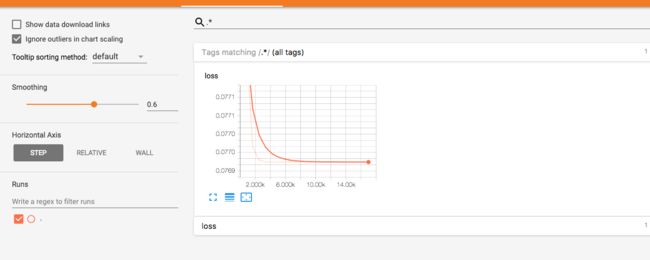前言
这是对TensorBoard的简单使用 。
简介
Tensorboard是一个web应用程序套件,用于检查tensorflow程序的运行情况。可以直观了解训练情况。
使用
使用summary op。用上一篇文章的例子,用tensorboard记录cost的变化。
加入summary
把待观察的op加入到summary op 的scalar中
# 创建summary来观察损失值
tf.summary.scalar("loss", cost)
合并summary op
如果summary op过多需要合并一下。
merged_summary_op = tf.summary.merge_all()
指定保存log文件路径
其实tensorboard的原理就是程序运行完了之后产生log文件,这个东西就是让log数据可视化的显示出来。
那么既然是文件路径的话我们要指定保存文件路径。
logs_path="./example"
会话中执行
首先弄出一个保存的op,使用的是summary.FileWriter保存默认图。
#op 把需要的记录数据写入文件
summary_writer=tf.summary.FileWriter(logs_path,graph=tf.get_default_graph())
执行merged_summary_op
summary=sess.run(merged_summary_op,feed_dict={X: train_X, Y: train_Y})
summary_writer.add_summary(summary, epoch * n_samples)
详细代码
# -*- coding: utf-8 -*-
# @Time : 2017/12/5 上午9:28
# @Author : SkullFang
# @Email : [email protected]
# @File : demo2.py
# @Software: PyCharm
import tensorflow as tf
import numpy as np
import matplotlib.pyplot as plt
import random
#训练参数
learning_rate=0.01
traing_epochs=1000
display_step=50
logs_path="./example"
# 训练数据
train_X = np.asarray([3.3, 4.4, 5.5, 6.71, 6.93, 4.168, 9.779, 6.182, 7.59, 2.167,
7.042, 10.791, 5.313, 7.997, 5.654, 9.27, 3.1])
train_Y = np.asarray([1.7, 2.76, 2.09, 3.19, 1.694, 1.573, 3.366, 2.596, 2.53, 1.221,
2.827, 3.465, 1.65, 2.904, 2.42, 2.94, 1.3])
n_samples = train_X.shape[0]
#定义两个变量的op占位符
X=tf.placeholder("float")
Y=tf.placeholder("float")
#初始化w,b
W=tf.Variable(random.random(),name="weight")
b=tf.Variable(random.random(),name="bias")
#构造线性模型
pred=tf.add(tf.multiply(X,W),b)
#均方误差
#reduce_sum是对每一项进行加和
#reduce_sum(x,0)是每一列进行加和,reduce_sum(x,1)是对每一行进行加和
cost=tf.reduce_sum(tf.pow(pred-Y,2))/(2*n_samples)
#梯度下降
optimizer=tf.train.GradientDescentOptimizer(learning_rate).minimize(cost)
#初始化所有的变量
init=tf.global_variables_initializer()
# 创建summary来观察损失值
tf.summary.scalar("loss", cost)
merged_summary_op = tf.summary.merge_all()
#以上都是构造op,只是为了告诉tensorflow 模型的数据流动方向
#使用session 启动默认图
with tf.Session() as sess:
sess.run(init) #初始化
#op 把需要的记录数据写入文件
summary_writer=tf.summary.FileWriter(logs_path,graph=tf.get_default_graph())
for epoch in range(traing_epochs):
for (x,y) in zip(train_X,train_Y):
sess.run(optimizer,feed_dict={X:train_X,Y:train_Y})
if(epoch+1) % display_step==0:
# c, summary = sess.run([cost, merged_summary_op], feed_dict={X: train_X, Y: train_Y})
c= sess.run(cost, feed_dict={X: train_X, Y: train_Y})
summary=sess.run(merged_summary_op,feed_dict={X: train_X, Y: train_Y})
summary_writer.add_summary(summary, epoch * n_samples)
# c=sess.run(cost,feed_dict={X:train_X,Y:train_Y})
print("Epoch:", '%04d' % (epoch + 1), "cost=", "{:.9f}".format(c), \
"W=", sess.run(W), "b=", sess.run(b))
print ("optimization Finished")
training_cost = sess.run(cost,feed_dict={X:train_X,Y:train_Y})
print ("Training cost=",training_cost,"W=",sess.run(W),"b=",sess.run(b),"\n")
#画图
plt.plot(train_X,train_Y,'ro',label="Original data")
plt.plot(train_X,sess.run(W)*train_X+sess.run(b),label="Fitted line")
plt.legend()
plt.show()
plt.savefig('linear_train.png')
# 测试数据
test_X = np.asarray([6.83, 4.668, 8.9, 7.91, 5.7, 8.7, 3.1, 2.1])
test_Y = np.asarray([1.84, 2.273, 3.2, 2.831, 2.92, 3.24, 1.35, 1.03])
print("Testing... (Mean square loss Comparison)")
testing_cost = sess.run(
tf.reduce_sum(tf.pow(pred - Y, 2)) / (2 * test_X.shape[0]),
feed_dict={X: test_X, Y: test_Y}) # same function as cost above
print("Testing cost=", testing_cost)
print("Absolute mean square loss difference:", abs(
training_cost - testing_cost))
plt.plot(test_X, test_Y, 'bo', label='Testing data')
plt.plot(train_X, sess.run(W) * train_X + sess.run(b), label='Fitted line')
plt.legend()
plt.show()
plt.savefig('linear_test.png')
效果
1
程序运行完了之后程序目录中会多出一个sample的文件夹,里面就是我们的log文件
2
打开自己的终端
在项目目录下面执行,记得一定是在项目目录下执行。这里就是指定log的文件夹,和端口。
tensorboard --logdir=./example --host 0.0.0.0
这是执行完的效果。
在浏览器中打开
http://0.0.0.0:6006
这就是最终的效果。我们可以看到loss的下降,说明我们学习的很好。横坐标是轮数


